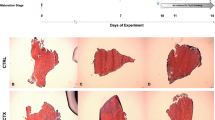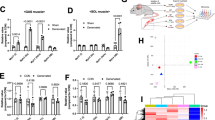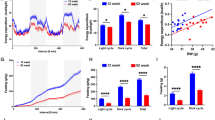Abstract
Uteroplacental insufficiency and subsequent intrauterine growth retardation (IUGR) affects postnatal metabolism. In juvenile rats, IUGR alters skeletal muscle mitochondrial gene expression and reduces mitochondrial NAD+/NADH ratios, both of which affect β-oxidation flux. We therefore hypothesized that gene expression and function of mitochondrial β-oxidation enzymes would be altered in juvenile IUGR skeletal muscle. To test this hypothesis, mRNA levels of five key mitochondrial enzymes (carnitine palmitoyltransferase I, trifunctional protein of β-oxidation, uncoupling protein-3, isocitrate dehydrogenase, and mitochondrial malate dehydrogenase) and intramuscular triglycerides were quantified in 21-d-old (preweaning) IUGR and control rat skeletal muscle. In isolated skeletal muscle mitochondria, enzyme function of the trifunctional protein of β-oxidation and isocitrate dehydrogenase were measured because both enzymes compete for mitochondrial NAD+. Carnitine palmitoyltransferase I, the trifunctional protein of β-oxidation, and uncoupling protein 3 mRNA levels were significantly increased in IUGR skeletal muscle, whereas mRNA levels of isocitrate dehydrogenase and mitochondrial malate dehydrogenase were unchanged. Similarly, trifunctional protein of β-oxidation activity was increased in IUGR skeletal muscle mitochondria, and isocitrate dehydrogenase activity was unchanged. Interestingly, skeletal muscle triglycerides were significantly increased in IUGR skeletal muscle. We conclude that uteroplacental insufficiency alters IUGR skeletal muscle mitochondrial lipid metabolism, and we speculate that the changes observed in this study play a role in the long-term morbidity associated with IUGR.
Similar content being viewed by others
Log in or create a free account to read this content
Gain free access to this article, as well as selected content from this journal and more on nature.com
or
Abbreviations
- CPTI:
-
carnitine palmitoyltransferase I
- IUGR:
-
intrauterine growth retardation
- AGA:
-
appropriate for gestational age
- ICD:
-
isocitrate dehydrogenase
- MMD:
-
mitochondrial malate dehydrogenase
- ND-4L:
-
NADH-ubiquinone oxidoreductase subunit 4L
- HADH:
-
trifunctional protein of β-oxidation
- HADHA:
-
trifunctional protein of β-oxidation α subunit
- UCP3:
-
uncoupling protein 3
- UCP3l:
-
uncoupling protein 3—long isoform
- UCP3s:
-
uncoupling protein 3—short isoform
References
Barker DJP 1997 Maternal nutrition, fetal nutrition, and disease in later life. Nutrition 13: 807–813
Davies PSW, Clough H, Bishop NJ, Lucas A, Cole JJ, Cole TJ 1996 Total energy expenditure in small for gestational age infants. Arch Dis Child 74:F208
Bohler T, Kramer T, Janecke AR, Hoffmann GF, Linderkamp O 1999 Increased energy expenditure and fecal fat excretion do not impair weight gain in small for gestational age preterm infants. Early Hum Dev 54: 223–234
Scopes JW, Ahmed I 1966 Minimal rats of oxygen consumption in sick and premature newborn infants. Arch Dis Child 41: 407–416
Sinclair JC, Silverman WA 1966 Intrauterine growth in active tissue mass of the human fetus, with particular reference to the undergrown baby. Pediatrics 38: 48–62
Chessex P, Reichman B, Verellen G, Putet G, Smith JM, Heim T, Swyer PR 1984 Metabolic consequences of intrauterine growth retardation in very low birth weight infants. Pediatr Res 18: 709–713
Lane RH, Chandorkar AK, Flozak AS, Simmons RA 1998 Intrauterine growth retardation alters mitochondrial gene expression and function in fetal and juvenile rat skeletal muscle. Pediatr Res 43: 563–570
Eaton S, Bartlett K, Pourfarzam M 1999 Intermediates of myocardial mitochondrial β-oxidation: possible channelling of NADH and CoA esters. Biochim Biophys Acta 1437: 402–408
Eaton S, Bursby T, Middleton B, Pourfarzam M, Mills K, Johnson AS, Bartlett K 2000 The mitochondrial trifunctional protein: center of a β-oxidation metabolon. Biochem Soc Trans 28: 177–182
Eaton S, Bartlett K, Pourfarzam M 1996 Mammalian mitochondrial β-oxidation. Biochem J 320: 345–357
Salway JG 1994 Metabolism at a Glance. Blackwell Scientific, Oxford, 72–75.
Boss O, Hagen T, Lowell BB 2000 Uncoupling proteins 2 and 3 potential regulators of mitochondrial energy metabolism. Diabetes 49: 143–156
McGarry JD, Brown NF 1997 The mitochondrial carnitine palmitoyltransferase system. Eur J Biochem 244: 1–14
Boss O, Samec S, Paoloni-Giacobino A, Rossier C, Dulloo A, Seydoux J, Muzzin P, Giacobino JP 1997 Uncoupling protein-3: a new member of the mitochondrial carrier family with a tissue specific expression. FEBS Lett 408: 39–42
Samec S, Seydoux J, Dulloo AG 1999 Skeletal muscle UCP3 and UCP2 gene expression in response to inhibition of free fatty acid flux through mitochondrial β-oxidation. Eur J Physiol 438: 452–457
Ogata ES, Bussey ME, Finley S 1985 Altered gas exchange, limited glucose and branched chain amino acids and hypoinsulinism retard fetal growth in the rat. Metabolism 35: 970–977
Unterman TG, Simmons RA, Glick RP, Ogata ES 1993 Circulating levels of insulin, insulin-like growth factor-I (IGF-I), IGF-II, and IGF-binding proteins in the small for gestational age fetal rat. Endocrinology 132: 327–336
Ogata ES, Bussey ME, LaBarbera A, Finley S 1985 Altered growth, hypoglycemia, hypoalaninemia, and ketonemia in the young rat: postnatal consequences of intrauterine growth retardation. Pediatr Res 19: 32–37
Lane RH, Kelley DE, Gruetzmacher EM, Devaskar SU 2001 Uteroplacental insufficiency alters hepatic fatty acid-metabolizing enzymes in juvenile and adult rats. Am J Physiol R183–R190
Kelley DE, Goodpaster B, Wing RR, Simoneau JA 1999 Skeletal muscle fatty acid metabolism in association with insulin resistance, obesity, and weight loss. Am J Physiol E1130–1141
Chomczynski P, Sacchi N 1987 Single step method of RNA isolation by acid guanidinium thiocyanate-phenol-chloroform extraction. Anal Biochem 162: 156–159
Lane RH, Flozak AS, Simmons RA 1996 Measurement of GLUT mRNA in liver of fetal and neonatal rats using a novel method of quantitative polymerase chain reaction. Biochem Mol Med 59: 192–199
Lane RH, Crawford SE, Flozak AS, Simmons RA 1999 Localization and quantification of glucose transporters in liver of growth retarded fetal and neonatal rats. Am J Physiol E135–E142
Hu E, Liang P, Spiegelman BM 1996 AdipoQ is a novel adipose-specific gene dysregulated in obesity. J Biol Chem 271: 10697–10703
Trounce IA, Kim YL, Jun AS, Wallace DC 1996 Assessment of mitochondrial oxidative phosphorylation in patient muscle biopsies, lymphoblasts, and transmitochondrial cell lines. In: Attardi GM, Chomyn A (eds) Methods in Enzymology: Mitochondrial Biogenesis and Genetics. San Diego, Academic Press, 485–491.
Lattari A, Daood MJ, Sieck GC, Watchko JF 1997 Rat diaphragm oxidative capacity, antioxidant enzymes, and fatigue: newborn versus adult. Pediatr Res 42: 60–65
Venizelos N, Ijlst L, Wanders RJ, Hagenfeldt L 1994 β-oxidation enzymes in fibroblasts from patients with 3-hydroxdicarboxylic aciduria. Pediatr Res 36: 111–114
Folch J, Lees M, Sloane-Stanley GH 1957 A simple method for the isolation and purification of total lipids from animal tissues. J Biol Chem 226: 497–509
Frayn KN, Maycock PF 1980 Skeletal muscle tracylglycerol in the rat: methods for sampling and measurement, and studies of biological variability. J Lipid Res 21: 131–144
Mollica MP, Iossa S, Liverini G, Soboll S 1999 Stimulation of oxygen consumption following addition of lipid substrates in liver and skeletal muscle from rats fed a high-fat diet. Metabolism 48: 1230–1235
Eaton S, Bhuiyan AKMJ, Kler RS, Turnball DM, Bartlett 1993 Intramitochondrial control of the oxidation of hexadecanoate in skeletal muscle. A study of acyl-CoA esters which accumulate during rat skeletal-muscle mitochondria beta-oxidation of [U-14C] hexadecanoate and [U-14C] hexadecanoyl-carnitine. Biochem J 289: 161–168
Williamson JR, Cooper RH 1980 Regulation of the citric acid cycle in mammalian systems. FEBS Lett K73–K85
Porpaczy Z, Sumegi B, Alkonyi I 1987 Interaction between NAD-dependent isocitrate dehydrogenase alpha-ketoglutarate dehydrogenase complex and NADH: ubiquinone oxidoreductase. J Biol Chem 262: 9509–9514
Ibdah JA, Bennett MJ, Rinaldo P, Zhao Y, Gibson B, Sims HF, Strauss AW 1999 A fetal fatty-acid oxidation disorder as a cause of liver disease in pregnant women. N Engl J Med 340: 1723–1731
Innes AM, Seargeant LE, Balachandra K, Roe CR, Wanders RJ, Ruiter JP, Casiro O, Grewar DA, Greenberg CR 2000 Hepatic carnitine palmitoyltransferae I deficiency presenting as maternal illness in pregnancy. Pediatr Res 47: 43–45
Kerner J, Bieber L 1990 Isolation of a malonyl-CoA-sensitive CPT/beta-oxidation enzyme complex from heart mitochondria. Biochemistry 29: 4326–4334
Alam N, Saggerson ED 1998 Malonyl-CoA and the regulation of fatty acid oxidation in soleus muscle. Biochem J 334: 233–241
Ruderman NB, Saha AK, Vavvas D, Witters LA 1999 Malonyl-CoA, fuel sensing, and insulin resistance. Am J Physiol E1–E18
Dyck DJ, Miskovic D, Code L, Luiken JJFP, Bonen A 2000 Endurance training increases FFA oxidation and reduces triacylglycerol utilization in contracting rat soleus. Am J Physiol E778–E785
Ebeling P, Essen-Gustavsson B, Tuominen JA, Koivisto VA 1998 Intramuscular triglyceride content is increased in IDDM. Diabetologia 41: 111–115
Sreenan S, Keck S, Fuller T, Cockburn B, Burant CF 1999 Effects of troglitzaone on substrate storage and utilization in insulin resistant rats. Am J Physiol E1119–E1129
Schrauwen P, Wagenmakers AJM, van Marken Lichtenblet WD, Saris WHM, Westerterp 2000 Increase in fat oxidation on a high-fat diet is accompanied by an increase in triglyceride-derived fatty acid oxidation. Diabetes 49: 640–646
Yki-Jarvinen H, Puhakainen I, Saloranta C, Groop L, Taskinen MR 1991 Demonstration of a novel feedback mechanism between FFA oxidation from intracellular and intravascular sources. Am J Physiol E680–E689
Dan PA, Lillioja S, Kriketos AD, Milner MR, Baur LA, Bogardus C, Jenkins AB, Storlien LH 1997 Skeletal muscle triglyceride levels are inversely related to insulin action. Diabetes 46: 983–988
Perseghin G, Scifo P, De Cobelli FD, Pagliato E, Battezzati A, Arcelloni C, Vanzulli A, Testolin G, Pozza G, Maschio AD, Luzi L 1999 Intramyocellular triglyceride content is a determinant of an in vivo insulin resistance in humans. Diabetes 48: 1600–1606
Muzzin P, Boss O, Giocobino JP 1999 Uncoupling protein-3: its possible biological roles and mode of regulation in rodents and humans. J Bioenerg Biomembr 31: 467–473
Vidal-Puig AJ, Grujic D, Zhang CY, Hagen T, Boss O, Ido Y, Szczepanik A, Wade J, Mootha V, Cortright R, Muoio DM, Lowell BB 2000 Energy metabolism in uncoupling protein 3 gene knockout mice. J Biol Chem 275: 16258–16266
Acknowledgements
The authors thank Dr. Sherin Devaskar for her support and guidance.
Author information
Authors and Affiliations
Corresponding author
Additional information
This research was supported, in part, by National Institute of Child Health and Human Development grants P30HD-28836-05 (R.H.L.), 1KO8BD01225-01 (R.H.L.), and 5P30-DK46204-05 (R.H.L.), and the Magee-Womens Hospital Twenty-Five Club.
Rights and permissions
About this article
Cite this article
Lane, R., Kelley, D., Ritov, V. et al. Altered Expression and Function of Mitochondrial β-Oxidation Enzymes in Juvenile Intrauterine-Growth-Retarded Rat Skeletal Muscle. Pediatr Res 50, 83–90 (2001). https://doi.org/10.1203/00006450-200107000-00016
Received:
Accepted:
Issue date:
DOI: https://doi.org/10.1203/00006450-200107000-00016
This article is cited by
-
Nutritional programming in fishes: insights from mammalian studies
Reviews in Fish Biology and Fisheries (2020)
-
Postnatal high-fat diet enhances ectopic fat deposition in pigs with intrauterine growth retardation
European Journal of Nutrition (2017)
-
In utero and early life exposure to diesel exhaust air pollution increases adult susceptibility to heart failure in mice
Particle and Fibre Toxicology (2013)
-
Uteroplacental insufficiency down regulates insulin receptor and affects expression of key enzymes of long-chain fatty acid (LCFA) metabolism in skeletal muscle at birth
Cardiovascular Diabetology (2008)
-
Undernutrition during suckling in rats elevates plasma adiponectin and its receptor in skeletal muscle regardless of diet composition: a protective effect?
International Journal of Obesity (2008)



